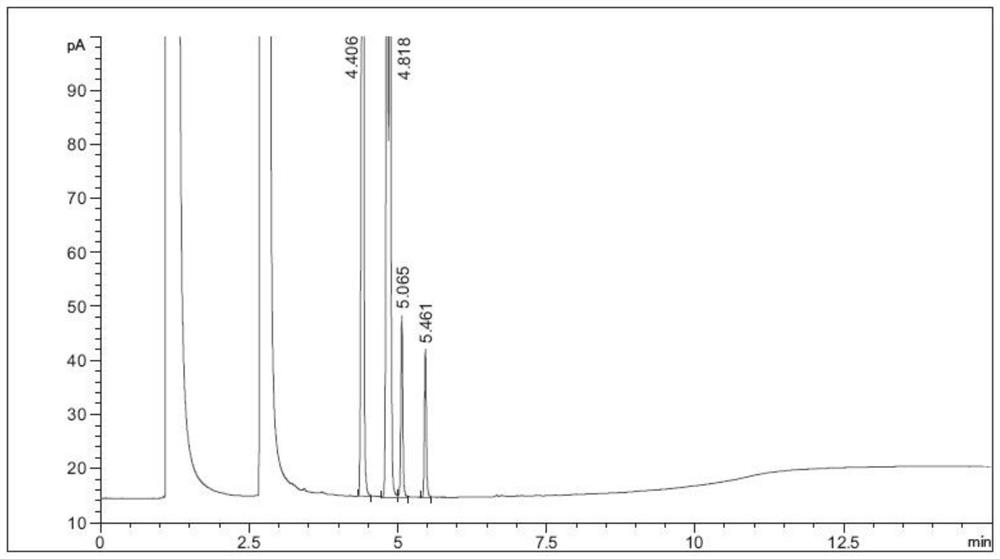Detection method and application of polyhydric alcohol
A detection method and polyol technology, applied in the field of analysis and detection, can solve the problems of less quantitative research on diethylene glycol tripropylene glycol
- Summary
- Abstract
- Description
- Claims
- Application Information
AI Technical Summary
Problems solved by technology
Method used
Image
Examples
Embodiment 1
[0073] Embodiment 1 (system suitability test)
[0074] A detection method for polyalcohols, comprising the steps of:
[0075] Detect with 7890A gas chromatograph, workstation is Open LAB chromatographic workstation (Agilent Technologies Co., Ltd.), and detector is FID detector, and chromatographic condition is:
[0076] The chromatographic column is an Agilent DB-WAX UI capillary column (30.0m×0.32mm, 0.25μm),
[0077] The carrier gas is high-purity nitrogen, the carrier gas flow rate is 3.0ml / min, the split ratio is 5:1, the inlet temperature is 220°C, the detector temperature is 250°C, the injection volume is 2μl, and the column temperature is raised according to the temperature program For detection, the specific heating program is as follows: the initial temperature is 120°C, the temperature is raised to 230°C at a speed of 10°C / min, and the temperature is kept for 25 minutes.
[0078] Solution preparation:
[0079] Blank solution (i.e. diluent): methanol solution of 1,...
Embodiment 2
[0090] Embodiment 2 (detection limit and quantitative limit)
[0091] The detection method is the same as in Example 1.
[0092] Solution preparation:
[0093] Weigh an appropriate amount of dipropylene glycol reference substance, diethylene glycol reference substance, and tripropylene glycol reference substance, and dilute them step by step with a blank solution to form a series of solutions with different concentrations, take 2 μl each, and detect them sequentially. The signal-to-noise ratio is approximately The injection concentration at 3 o'clock was used as the detection limit, and the injection concentration at about 10 when the signal-to-noise ratio was taken as the quantification limit. The detection limits of dipropylene glycol, diethylene glycol, and tripropylene glycol were measured to be 0.18, 0.15, and 0.45 μg / mL, respectively, and the quantification limits of dipropylene glycol, diethylene glycol, and tripropylene glycol were 0.60, 0.50 μg / mL, respectively. , 1...
Embodiment 3
[0094] Embodiment 3 (linear test)
[0095] The detection method is the same as in Example 1.
[0096] Solution configuration:
[0097] Accurately weigh the appropriate amount of dipropylene glycol reference substance, diethylene glycol reference substance, and tripropylene glycol reference substance, and dilute it with a blank solution to make about 5 mg of dipropylene glycol, 0.05 mg of diethylene glycol, and tripropylene glycol in each 1 ml. Propylene glycol 1.5mg linear stock solution; accurately measure 0.5ml of linear stock solution, put it in a 50ml measuring bottle, dilute to the mark with blank solution, shake well, and use it as linear No. 1 solution; precisely measure linear stock solution 0.5ml, 1ml, Put 2ml, 3ml, and 4ml into 20ml measuring bottles respectively, dilute to the mark with blank solution, shake well, and use it as linear solution No. 2-6. Precisely measure 2 μl each of the linear solutions No. 1-6, inject them into the gas chromatograph respectively,...
PUM
| Property | Measurement | Unit |
|---|---|---|
| length | aaaaa | aaaaa |
| thickness | aaaaa | aaaaa |
| length | aaaaa | aaaaa |
Abstract
Description
Claims
Application Information
 Login to View More
Login to View More - R&D
- Intellectual Property
- Life Sciences
- Materials
- Tech Scout
- Unparalleled Data Quality
- Higher Quality Content
- 60% Fewer Hallucinations
Browse by: Latest US Patents, China's latest patents, Technical Efficacy Thesaurus, Application Domain, Technology Topic, Popular Technical Reports.
© 2025 PatSnap. All rights reserved.Legal|Privacy policy|Modern Slavery Act Transparency Statement|Sitemap|About US| Contact US: help@patsnap.com



